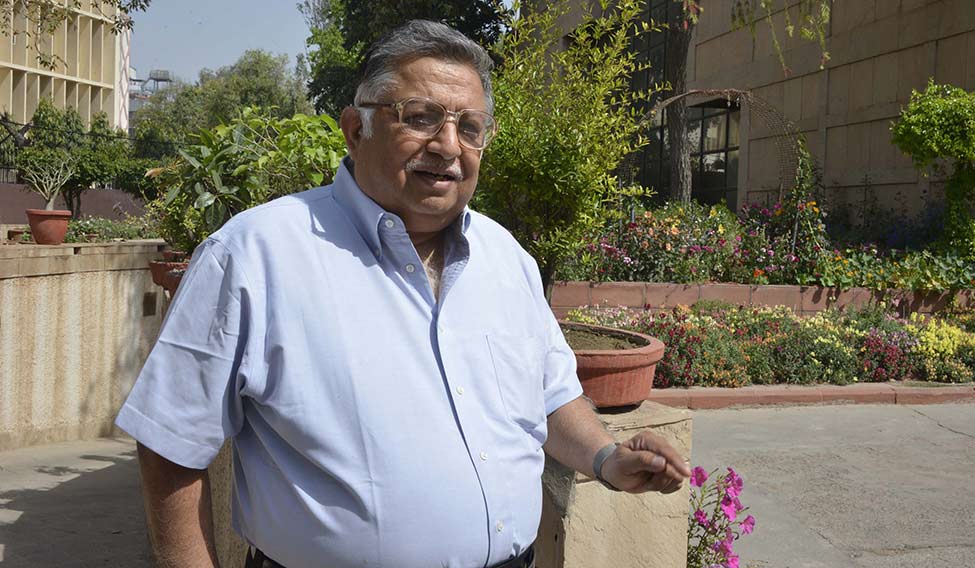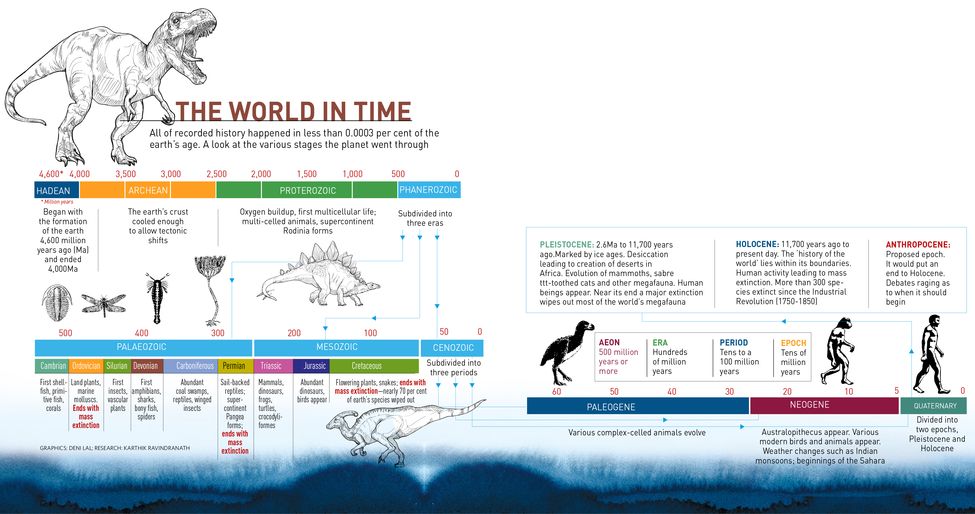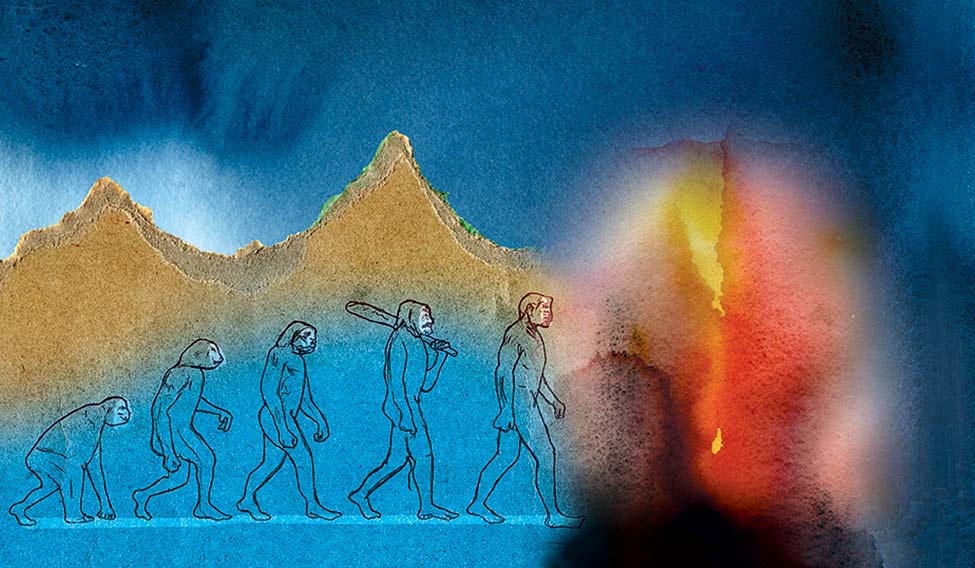It is a thick chocolate-coloured streak with an exceptional amount of iridium, seen in several geological sites across the earth. On the layers below it, there is a treasure trove of fossilised dinosaur remains to be picked. Just above it, there is scant evidence of anything resembling a giant lizard. This line on the rock of the multilayered sedimentary cake of earth’s history tells, in rather vivid detail, the story of an event 66 million years ago, when one period (Cretaceous) came to an abrupt end, and phoenix-like, another (Paleogene) began (see graphics on page 124). This is the story:
It seemed an ordinary Cretaceous day. The realm was ruled by dinosaurs. Herds of the big lizards were busy chewing their way through foliage on an earth that was much warmer than the present day. The dinosaurs lurked, stalking their prey and selecting the most vulnerable of the herd to pounce upon. In the waters, their cousins dived deep and hunted fish and other lizards. Life on earth was going on as it had been for hundreds of years when, suddenly, a 10km ball of fire whizzed into the atmosphere and landed in a place now called New Mexico.
In the seconds, minutes, days and weeks that followed, everything changed. As the asteroid (as scientists now believe it was, from the iridium it deposited) whizzed in, it heated up the air, and its landing was such a violent one that it threw up thousands of bits of smouldering rock into the atmosphere, causing a cataclysmic pyrotechnic show. Hot became an understatement. Within hours, as these rocks fell back to earth, they triggered forest fires. Already, the asteroid had shaken up the earth so badly that there were tsunamis and quakes. There weren’t too many places to escape to, and the Great Extinction began, as animals and plants began dying instantly.
The tenuous ones witnessed worse. Within weeks, the air became so thick with dust that a Delhi smog must have seemed a clear day. With barely a weak sun filtering in, photosynthesis was suspended, causing a death by starvation to entire food chains. A long, bleak winter set in, killing all but the extremely resilient. Nearly 70 per cent of the earth’s species was wiped out within a period as short as around ten years or so, believe scientists.
What remained, adapted and evolved to a new world. In time, it was to prosper, wiping out almost all memory of the previous realm, except what remained in fossils. A fading footprint.
 Ashok Singhvi
Ashok Singhvi
CUT TO THE PRESENT. Are we, right now, standing on another such line? This is a debate that is raging in scientific circles around the world, as geologists, stratigraphers (who study the rock strata of earth), climate change specialists and atmosphere scientists look at the changes being wrought on earth by the actions of a single, dominant species, Homo sapiens.
Brian Huber, paleobiologist at Washington’s Smithsonian Institution and National Museum of Natural History, said, “We are well past that point where human activity can determine the direction that the earth’s future will take. Humans have released 550 billion tonnes of carbon dioxide into the atmosphere since 1870 and more than half of that has been since 1970.” Huber is also vice chair of the International Commission on Stratigraphy (ICS), a top-notch scientific organisation that classifies time on earth on geological scales, based on evidence left behind on rock strata.
Carbon emissions are not the only human-aided change. Mass migrations of fauna and huge extinctions of biodiversity are other changes. Domestication and selective breeding of plants and animals have taken over what natural selection did earlier. Creation of synthetic polymers like plastic and polythene, which have long biodegrading cycles, is yet another.
There has been a demand to give a formal recognition to human impact on earth since quite some time. In 1873, Italian geologist Antonio Stoppani coined the term ‘anthropozoic’ to acknowledge the increasing human impact on earth systems. The term anthropocene was coined by biologist Eugene Stoermer in the 1970s, but it was made popular by Nobel Prize-winning chemist Paul Crutzen. In 2008, geologist Jan Zalasiewicz pressed the demand for naming a geological stage after it. The University of Leicester, United Kingdom, has been spearheading the movement since.

Last autumn was a landmark one, as the International Union of Geological Sciences (IUGS) accepted that there was enough evidence to terminate the Holocene epoch (that began 11,700 years ago) and name a new epoch after humans, the Anthropocene (literally, new man). The union, an apex body of geologists, agreed that human beings had tampered enough with the earth to not just leave a mark on the strata of time, but also to influence the future of the planet. They also agreed that the 1950s should be taken as the boundary of the two epochs.
This latter decision put some finality to another raging discussion among those who agreed with the idea of the Anthropocene, but could not agree on when it should begin. Should it begin with the advent of agriculture (around 10,000 years ago, and thereby almost subsume the Holocene) or should the starting point be the Industrial Revolution, between mid-1700s to mid-1800s? Some had even argued that the Renaissance (1300s-1600s) was as good a time as any other to kickstart the Anthropocene.
The business of classifying time in geological scales is complicated. Geologists use rock strata as a time piece; the deeper the layer, the older the time period in which it was created. Every line on the rock or ice core tells a story, of the animals that walked upon it, the fruit that fell on it and the ravages of nature it endured. Two geological time zones are separated by a ‘universal marker’—a record of some major event on earth due to which it slid from one stage to another. The chocolate-coloured radioactive streak, for instance, is the transition point between Cretaceous and Paleogene periods. Chocolate because of the iron from the meteorite, radioactive with iridium. A similar brown line marks the Permian-Triassic boundary 250 million years ago.
“All boundaries may not be so visually evident,” explained Narendra Bhandari, who retired as chair of the Planetary Science and Exploratory Division at Ahmedabad’s Physical Research Laboratory. “The beginning of the Holocene [present time] was not marked by a meteorite hit or volcano, but by the end of glaciation.” Bhandari discovered two boundaries in India during the 1990s, one singalling the end of the dinosaur rule in Anjar, Gujarat and another demarcating the Permian and Triassic periods in Spiti, Himachal Pradesh.
This ‘line on the rock’ has to be universal, which means that it must be seen at several points across the globe, and should denote the same point in time everywhere. The Industrial Revolution didn’t happen simultaneously the world over; its results took a century to spread globally. Agriculture, too, took over a millennium to spread all over. The IUGS, therefore, agreed to choose the mid-1950s, the time when there were large atmospheric nuclear tests, as the starting point for the Anthropocene. The radionuclides from these tests have scattered across the globe, settling on rock strata, marine and lake beds, and will pop up in sediments of the same vintage, thousands and millions of years later.
Getting a consensus, however, does not mean that the Anthropocene is official. It is only the beginning of a tedious and calibrated process to find enough evidence that satisfies the ICS and a host of other scientific bodies.
Classically, the ‘line’ should also demarcate a change in the earth before and after. Scientists call this the ‘primary signal’, but it should also be accompanied by a host of chemical, paleontological and magnetic evidence in support. Once the working group is able to satisfy a host of scientific committees on the line (technically known as Global Boundary Stratotype Section or Point, of GSSP), the search starts for a place on earth where an official plaque or ‘golden spike’ can be placed. This does not mean the line does not appear elsewhere; it only means that this site is designated as an official marker, and is preserved as such.
The Cretaceous-Paleogene boundary, for instance, is marked at a site near El Kef in Tunisia. The process is so long, and there are so many dissenting opinions, that only 64 of the 101 geological stages that need a marker have been officially defined. Mudh village in Spiti Valley has a rock that was selected to mark the lower boundary of the Olenekian age (a time of early dinosaurs and early mammals), 251.2 million years ago, but it is yet to get the golden spike.
The challenge facing scientists is two-fold—not only do they have to find that elusive line, but they also have to gather enough evidence of changes. “This is a tall order,” said Bhandari. “We are standing on that line right now; it is still being created. How can they find satisfactory evidence at this stage? Maybe in another few thousand years, our descendants could look at the rocks and point to this century and say, yes, here is where the earth changed. But it is too early right now.”
In fact, not all scientists are certain that humans have spiralled the earth onto a trajectory which it may not have taken without our interference. “No scientist will deny human impact on earth. Species extinction has been accelerated [by one estimate 20,000 species disappear every year]. We have moved the earth so much over the last decades that it is almost comparable with what the natural geological processes of the planet took billions of years to move. Also, we have created new material like plastics and ceramic,” said Ashok Singhvi, nuclear physicist-turned geoscientist, who devised the only known method in the world of dating sand dunes in deserts. “I have doubts on two points. Have we reached tipping point? And, have we altered nature beyond variables? For instance, if we talk about changing rainfall patterns, we really need to study what the pattern is over millions of years before concluding that human impact has changed it beyond its normal variables.”
David Harper, chair of the ICS, told THE WEEK that the Anthropocene has a good historical record already, but it might just be an ephemeral interval within the Holocene, which may or may not be preserved. To progress to the point of an official classification, whatever evidence is gathered to prove 1950s as the beginning of the Anthropocene has to be cleared by the executive and chair of 16 subcommissions of the ICS, before it is ratified by the IUGS.
Have the geologists taken a gamble by narrowing down the boundary to less than a decade, which is not even a blink on the geological scale? Demarcating two epochs might need a transition of a few centuries, if not millenia. “I don’t agree. The epochs could change rather quickly. One meteorite hit was enough to change the world within moments,” reasoned Bhandari, talking about the dinosaur extinction event. “Unfortunately, our dating tools do not have the resolution to pin down the exact decade when we are looking at geological time scales.”
These are only a few of the numerous doubts and questions facing the Anthropocene Working Group (AWG), a team of 33 experts from diverse disciplines, which is tasked with finding proof that will satisfy all these requirements. They are currently putting their heads together, embarking on research projects and scrutinising lake and marine sediments, cave deposits and glacial ice to look for evidence of key signals that could indicate Anthropocene—an evidence that will last into other epochs.
And what exactly are these signals? Indeed, what is it that a fossil finder of a future epoch would dig our from the layer termed Anthropocene? Zalasiewicz, chair of the AWG, in a compelling book called The Earth After Us, said humans come out firmly on top when it comes to producing traces. But a lot of what we consider immortal today would vanish without a trace. The ruins of the imposing Angkor Wat would be “totally absorbed back into nature” in some thousands of years. The music of Mozart and Beethoven is only as immortal as the human race.
Would then, a shard of glass, opaqued over time, tell the story of a once imposing skyscraper? Perhaps a chunk of road and bits of metallic pipes would give an idea of the empire of today. Fossilised chicken bones could tell them of our diet, industry-bred chicken having become the universally favourite meat after WWII, but the recipes would have vanished. Plastic has reached even the Mariana Trench, the deepest point in the Pacific.Will it become preserved in the sediment, to be dug out by beachcombers in a future when the seas have moved?
Today, we know what vegetation dominated earth at various stages, studying fossilised pollen, petrified wood and leaf. Would human-accelerated deforestation leave a clue in the absence of these fossils? The surge in carbon dioxide, methane and other gases would have been recorded in some ice core; nuclear reactors and weapons would certainly leave behind radioactive traces. Nearly 200 human-aided minerals as well as ‘rocks’ like concrete, too, may disappear with us; their trace on the Anthropocene strata will remain with our bones though.
Scientific exercises like naming a new geological stage are usually open-ended and could take several decades. This time, though, there is a sense of urgency, and the AWG hopes to present substantial proof at the 2020 meeting of the IUGS in New Delhi. The Anthropocene, after all, is not only a geological concern, but also a geopolitical one. Soon after Donald Trump’s inauguration as US president, the Doomsday Clock moved another thirty seconds closer to midnight. Maintained by the Bulletin of the Atomic Scientists, this clock represents the threat of the world moving towards a human-caused global catastrophe.
This brings us to the question of the end. When is Anthropocene likely to end? Are we going to self-annihilate, either by playing with nuclear material, or by drowning in rising seas of our own creation? Could we steer ourselves from the brink of disaster? Or, does the earth have its own devious plans?
The earth goes through periods of glaciation every 10,000 years or so, and we have already had an interglacial phase of 11,700 years. It is not just the Starks of Game of Thrones who ominously declare, “Winter is Coming”. There is one lobby that strongly believes the next glaciation is upon us, it could be even in the next ten years. “Global warming, if at all engineered by humans, is then, actually pushing the inevitable, even if by a few degrees,” said Bhandari. If not the ice, would it be another meteorite that finishes us? On one point, scientists seem to concur. Humans are on earth for a brief period in time; they will be obliterated some day, to be replaced by some other dominant form.
Zalasiewicz, in his book, wondered what future investigators will think as they sift through the Anthropocene strata. Would they sympathise that this remarkable species (humans) had the bad luck to make an appearance just as the planet was beginning a major climatic and environmental reorganisation, so it perished? Or, would they marvel at a species that combined high intelligence with breathtaking stupidity, which even as it was dominating the planet, dismantled the very systems that kept the world stable?
Time will tell, through its diary etched on the rock of ages.








